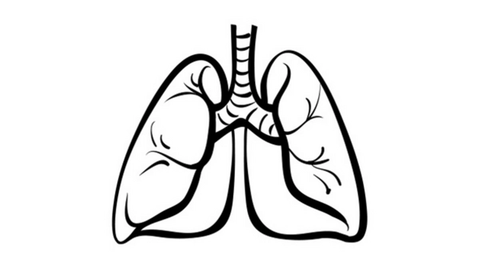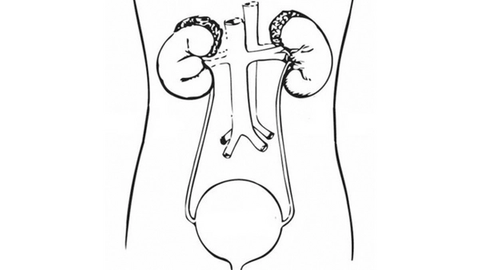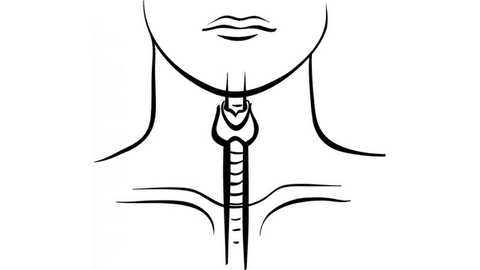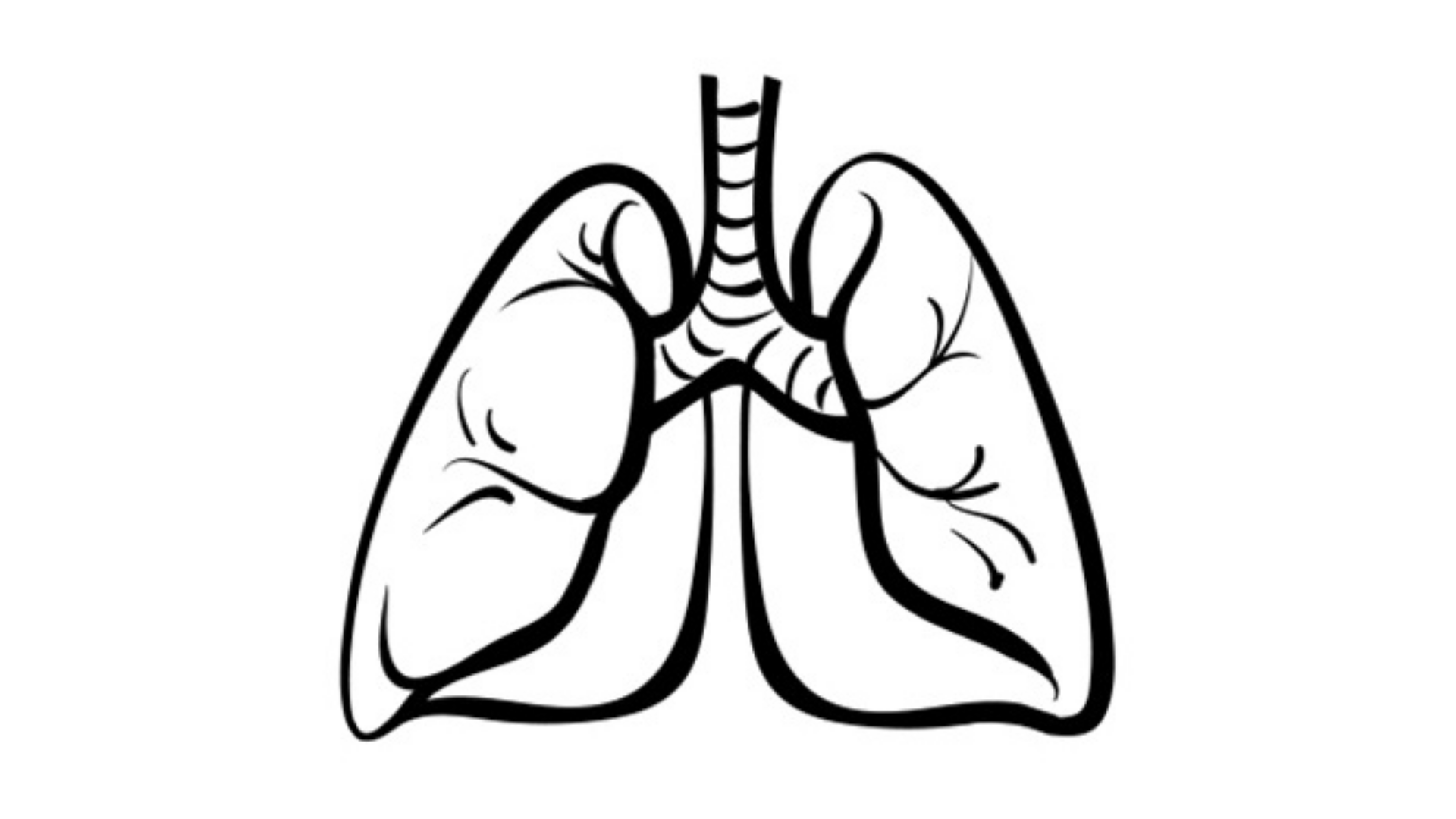Luke Discusses Hedgehog Inhibitors for Basal Cell Carcinoma
An 88-year-old man presented with a nonhealing ulcer on the lateral aspect of his nose. The patient was diagnosed with Basal cell carcinoma.
Jason Luke, MD

During a Targeted OncologyTM Case-Based Roundtable event, Jason Luke, MD, associate professor of Medicine, Division of Hematology/Oncology, and director, Cancer Immunotherapeutics Center UPMC Hillman Cancer Immunology and Immunotherapy Program at UPMC Hillman Cancer Center in Pittsburgh, PA, discussed the use of hedgehog inhibitors to treat Basal cell carcinoma.

Targeted OncologyTM: What are some risk factors for recurrence of basal cell cancer?
LUKE: The National Comprehensive Cancer Network [NCCN] guidelines split BCC into low-risk and high-risk categories using risk factors that are associated with recurrence, which help to stratify treatment of patients.1
The low-risk category is determined by the location and size of the lesion. Lesions less than 2 cm are considered low risk. Additionally, whether borders are well defined and whether it is a primary lesion or a recurrent one determine risk category. Other considerations include presence of comorbidities, systemic immunosuppression such as a bone marrow transplant, and features on the pathology report. Nodular and superficial subtypes tend to be low risk. Absence of perineural involvement is a low-risk factor.
High-risk lesions are concerning. If it’s on the trunk but greater than 2 cm and if it arises in anatomically sensitive areas like the cheeks, forehead, scalp, neck, and pretibial, then that is an issue. The mask areas of the face such as central face, eyelids, chin and mandible, and the genitalia, hands, and feet are also high-risk areas. The higher risk is because of the sensitivity surrounding management and likelihood of recurrence. Lesions that grow out of a site of radiation tend to be more aggressive.
Considering the patient’s high risk of recurrence, what are the various treatment options?
The NCCN guidelines outline systemic therapy options in BCC with a high risk of recurrence. Hedgehog pathway inhibitors [HHIs] are approved, but it’s worth noting that because of the frequency of intolerable adverse events [AEs], these drugs often require drug holidays or alternative dosing schedules to maintain quality of life.1
Vismodegib [Erivedge] and sonidegib [Odomzo] are approved, and more recently cemiplimab [(Libtayo) was approved by the FDA]. It is indicated for locally advanced BCC [laBCC] or metastatic BCC [mBCC] previously treated with an HHI or for those for whom an HHI is not appropriate.2 I think with cemiplimab-rwlc, the FDA has given physicians a fair amount of leeway to do whatever is best in each scenario. Discussing a case like this among peers is useful in [determining] when an HHI is appropriate and when other approaches are better.
For a patient on sonidegib who uses significant amounts of narcotics for the pain, is there any HHI that causes less pain, or is this a class effect for everyone?
It is probably a class effect, although not completely. Pain syndrome is not the most common AE that people describe, but these drugs are not easy to take. It is likely that a patient would have trouble with any of the approved drugs, but switching it is reasonable because occasionally it’s an idiosyncratic thing.
How does the Hedgehog pathway work? What data support use of HHIs in BCC?
The Hedgehog pathway is not a pathway people think about a lot. Under physiologic conditions, PTCH1 interacts with the smoothened [SMO] receptor and turns it off. This releases GLI into the nucleus and inhibits Hedgehog target genes. So the pathway is off, but the inhibitory interaction is on. When an HHI is given, it interrupts that interaction and allows the SMO receptor to function, which breaks down GLI and allows transcription of Hedgehog target genes that turn on the pathway. So PTCH turns off SMO receptors, and GLI regulates the Hedgehog pathway.3,4
The indications for vismodegib and sonidegib are slightly different. Vismodegib is approved for mBCC, but both are approved for laBCC. Especially in elderly patients or patients with [worse] performance status, starting at the full dose can be difficult, and people sometimes start lower and go up to the full dose if they can.5,6
There are some drug interactions for both, but the big one to remember is their AE profile. Muscle spasm, arthralgia, alopecia, anorexia, weight loss, nausea, vomiting, fatigue, and increased creatinine kinase are all common AEs. Most patients eventually get these symptoms, and for that reason, it’s unusual to treat a patient continuously to the point of progression because they just can’t keep taking the drugs over a long period.7
The overall response rate [ORR] for vismodegib in laBCC is 43%, and in mBCC it’s slightly lower, at 30%. For sonidegib, it is 44% in laBCC. So almost half of the patients will have an immediate response. Most patients will have disease control to some degree, if not an outright full RECIST quality response.8,9
The ERIVANCE trial [NCT00833417] was a 2-armed phase 2 trial of vismodegib. One group had mBCC with RECIST measurable disease, and the other group had laBCC with a composite end point looking at improvement in quality of life. The patients with laBCC were those deemed to be inoperable or in whom surgery was inappropriate. The primary end point was ORR. Dose of vismodegib used was 150 mg.8
The independently assessed ORR was 30% for mBCC. Most patients had at least stable disease or some tumor control. The ORR was higher in those with laBCC, at about 43%, with most patients having some level of tumor reduction. A small group of patients had progressive disease. The duration of response [DOR] was 7.6 months in both cohorts. In clinical practices, it’s uncommon for patients to continuously take this kind of medicine for more than 6 months.8
What are some expected AEs for vismodegib?
Gastrointestinal toxicities are quite common. The various ones such as nausea, vomiting, diarrhea, and constipation occur in the 15% to 30% range. General [AEs include] fatigue syndrome, which is [about] 40%, but it’s probably higher than that. Weight loss occurs in about half of patients, muscle spasms in 72% of patients, and other things like nervous system symptoms and alopecia [occur].5 There are not so many grade 3 and 4 toxicities because generally speaking, the patient is not willing to take it long enough to actually get severe toxicities. Continuous grade 1 and 2 toxicities can be even harder on a patient than a day of grade 3 or 4 toxicities.
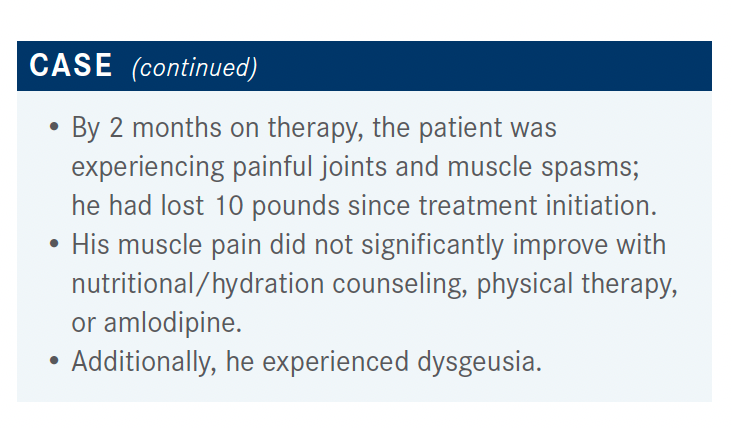
Alopecia is common in these patients. This is due to a decrease in dermal papillae function or hair growth that can sometimes be mitigated with minoxidil [Rogaine]. Another common AE is dysgeusia or ageusia, a decrease in bitter or sweet responsivity in taste buds. This can be hard on older patients especially because their appetite is not always very good to begin with, so they can completely stop eating and lose a lot of weight, leading to increased glucose uptake in muscle and brown adipocytes. Nutritional counseling can be done to improve eating. Muscle spasms are due to decreased myogenic factors and decreased injury recovery. Amlodipine has been used with some level of success.10 L-carnitine is also used, and there is some literature to support both approaches, but my personal experience is that they do not dramatically change the overall experience of the patient.
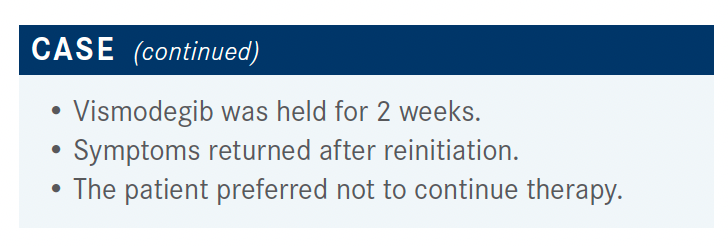
What treatment would you recommend next? What data support the use of cemiplimab in laBCC after HHI use?
The data for cemiplimab were presented at the European Society for Medical Oncology [Virtual Congress] 2020. The data presented were for laBCC after HHI use from a 2-armed phase 2 clinical trial. Patients were treated with intravenous [IV] cemiplimab 350 mg every 3 weeks for up to 93 weeks. Tumors were assessed by RECIST and restaged initially every 9 weeks and then every 12 weeks. Probably many patients you treat in your practice may not fit RECIST criteria because they lack certain characteristics to meet that. So it would be better if [the trial] patients did not have RECIST measurable disease.11
The primary end point was ORR, and key secondary [end points included DOR, overall survival (OS), and progression-free survival (PFS)]. The inclusion criteria were histologically confirmed BCC, prior progression or intolerance to an HHI or no better than stable disease after 9 months, at least 1 measurable baseline disease, and ECOG performance status of 0 or 1.11
The exclusion criteria were recent or ongoing autoimmune disease requiring immunosuppression, prior exposure to PD-1 or PD-L1 [inhibitors], or a concurrent malignancy other than BCC.11
[Results of a] study published in Lancet Oncology in 2021 showed the baseline patient demographics.12 The median age was about 70 years. In clinical practice, too, you are likely to see older patients presenting. Patients were predominantly male, which is common for distribution of this disease in the advanced setting. ECOG performance status was 0 in 60% of the patients, which may be a little high relative to what we see in real practice. The number of patients with prior radiotherapy was about half. About 70% of the patients had progression on an HHI and about 40% had some level of intolerance to previous HHI therapy. A small number [8%] had no better than stable disease [after 9 months of HHI therapy]. The primary site [of presentation was] mostly on the head and neck, at 75%.12
The ORR in the trial was 26%, which is a bit lower than that of checkpoint blockades in other cutaneous malignancies such as melanoma, Merkel cell cancer, and cutaneous squamous cell, but it’s still meaningful in the context of the trial. Only a minority of patients [6%] had complete responses, but stable disease was seen in about half of the patients.12
So in terms of disease control, it is less than that of HHIs, at 67%. Durable disease control is 50%. The median time to response was 4.3 months, which is a bit longer than what we see with PD-1 immunotherapy. Patients who had a DOR of over 6 months were almost 80% and almost 50% for a DOR greater than 12 months.12
With HHIs, the time to response is within a week, and in 2 weeks, the disease starts to shrink, but with cemiplimab, it shrinks more slowly. If patients had prior exposure to HHIs, their expectations are likely to be that it’s going to shrink right away because that’s what happened previously. This is an education point for patients and their families when using anti– PD-1 medications in BCC because the benefit is long term, as opposed to the immediate response benefit. Contrast that for them and help them feel comfortable that the drug is working.12
The median PFS at 6 months was 76%, and at 12 months it was 57%. So patients can get a durable benefit out of this treatment. For other skin cancers, patients can get the treatment and never progress. I hope we see that with cemiplimab, but it’s a bit hard to know based on the maturity of the data in this trial. The median OS was not reached at the time of data cutoff.12
For the safety evaluation of cemiplimab, treatment-related AEs of any grade were toxicities associated with anti–PD-1 use—so nothing that you would be surprised about because they have a certain toxicity spectrum.11,12
Grade 1 or 2 hypothyroidism was only about 10%, which is interesting because hypothyroidism shows up commonly in patients who are getting checkpoint blockade in other settings. There were grade 3-related AEs like colitis and adrenal insufficiency. It is important to educate patients to differentiate their baseline status from whatever develops over time, especially in older patients.11,12
From the package insert, AEs that show up are predominately lower grade. Grade 3 and 4 AEs are few. Fatigue is an issue to be cognizant of especially in elderly patients. Musculoskeletal issues and rash are obvious ones to look for. All the AEs are consistent with the standard anti–PD-1 therapies in use.13
REFERENCES:
1. NCCN. Clinical Practice Guidelines in Oncology. Basal cell skin cancer, version 2.2021. Accessed August 18, 2021. https://bit.ly/3Be4o4F
2. FDA approves cemiplimab-rwlc for locally advanced and metastatic basal cell carcinoma. FDA. Updated February 9, 2021. Accessed August 18, 2020. https:// bit.ly/3sqKRuB
3. Low JA, de Sauvage FJ. Clinical experience with Hedgehog pathway inhibitors. J Clin Oncol. 2010;28(36):5321-5326. doi:10.1200/JCO.2010.27.9943
4. Cucchi D, Occhione MA, Gulino A, De Smaele E. Hedgehog signaling pathway and its targets for treatment in basal cell carcinoma. J Exp Pharmacol. 2012;4:173-185. doi:10.2147/JEP.S28553
5. Erivedge. Prescribing information. Genentech USA Inc; 2020. Accessed August 18, 2021. https://bit.ly/3jlFDMw
6. Odomzo. Prescribing information. Sun Pharma Global FZE; 2019. Accessed August 18, 2021. https://bit.ly/3xkqGz1
7. Harris L. Basal cell carcinoma: a pharmacist’s guide. US Pharm. 2019;44(8):29-35. Accessed August 18, 2021. https://bit.ly/3xnc8Pd
8. Sekulic A, Migden MR, Oro AE, et al. Efficacy and safety of vismodegib in advanced basal-cell carcinoma. N Engl J Med. 2012;366(23):2171-2179. doi:10.1056/ NEJMoa1113713
9. Migden MR, Guminski A, Gutzmer R, et al. Treatment with two different doses of sonidegib in patients with locally advanced or metastatic basal cell carcinoma (BOLT): a multicentre, randomised, double-blind phase 2 trial. Lancet Oncol. 2015;16(6):716- 728. doi:10.1016/S1470-2045(15)70100-2
10. Lacouture ME, Dréno B, Ascierto PA, et al. Characterization and management of Hedgehog pathway inhibitor-related adverse events in patients with advanced basal cell carcinoma. Oncologist. 2016;21(10):1218-1229. doi:10.1634/ theoncologist.2016-0186
11. Stratigos AJ, Sekulic A, Peris K, et al. Primary analysis of phase II results for cemiplimab in patients (pts) with locally advanced basal cell carcinoma (laBCC) who progress on or are intolerant to hedgehog inhibitors (HHIs). Ann Oncol. 2020;31 (suppl 4):S1175-S1176. doi:10.1016/j.annonc.2020.08.2277
12. Stratigos AJ, Sekulic A, Peris K, et al. Cemiplimab in locally advanced basal cell carcinoma after hedgehog inhibitor therapy: an open-label, multi-centre, single-arm, phase 2 trial. Lancet Oncol. 2021;22(6):848-857. doi:10.1016/ S1470-2045(21)00126-1
13. Libtayo. Prescribing information. Regeneron Pharmaceuticals; 2021. Accessed August 18, 2021. https://bit.ly/3xlbjGH




